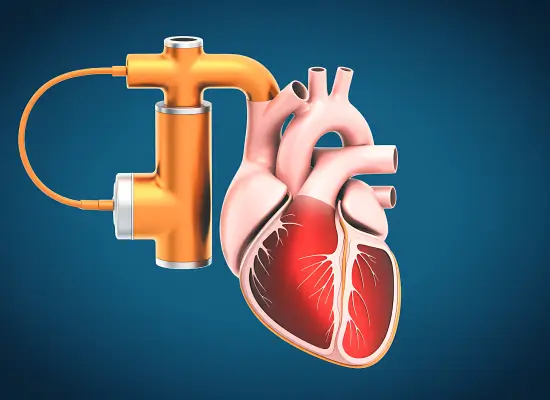A left ventricular assist device helps by pumping blood from the left ventricle to the aorta and the rest of the body. The left ventricular assist device is implanted in the heart's left ventricle, which helps the left ventricle pump blood to the aorta and other body parts.

- Introduction
- What is LVAD?
- Who Is The Right Candidate For LVAD?
- Bridge to transplant
- Destination Therapy (DT)
- Details of Procedure
- Management After the Procedure
- Precautions to Take After a Left Ventricular Assist Device
- Risk and Benefits of a Left Ventricular Assist Device Procedure
- Why Choose Gleneagles Hospitals for a Left Ventricular Assist Device Procedure?
- Conclusion
Introduction
A left ventricular assist device (LVAD) is a mechanical pump implanted in heart failure patients. The device helps pump blood from the left ventricle to the aorta and the rest of the body. It is an assisted device implanted in the left ventricle. Therefore, it is named a left ventricular assist device. If you want an LVAD procedure in Chennai, you should consider visiting Gleneagles Hospitals-- the leading hospital for LVAD treatment in Chennai.
What is LVAD?
LVAD, or left ventricular assist device, is a mechanical pump implanted to assist the heart's left ventricle in pumping blood to the aorta and other body parts. It is recommended for patients with severe heart failure and who fail to respond to medical therapy.
Who Is The Right Candidate For LVAD?
A left ventricular assist device is recommended for people with end-stage heart failure. It is recommended when people are waiting for a heart transplant. It can also help patients who are not candidates for heart transplants.

Bridge to transplant
When you are waiting for a heart transplant, your condition may worsen. This may cause aggravation of symptoms and damage to other organs such as the liver, kidneys, and lungs.
Bridge to transplant (BTT) helps you survive until you receive a donor’s heart. The LVAD procedure allows your heart to pump blood effectively to the body parts, and you can live a better life. The device can be removed at the time of a heart transplant.
The period for which you receive support from LVAD until heart transplantation is done depends on different factors such as your medical condition, body size, and blood type.
Your health matters – get expert advice today.
Destination Therapy (DT)
This therapy is recommended for people with heart failure but who are not patients for heart transplant surgery. This is recommended for patients who have tried other options, such as lifestyle changes, medications, and other heart procedures.
The left ventricular assist device helps such individuals by improving their quality of life for the rest of their lives.
The doctor will recommend a left ventricular assist device based on the medical conditions, body size, symptoms, and presence of other health problems in the patient.
Details of Procedure
1. Preoperative Preparation and Evaluation: The doctor will evaluate to see if you are the right candidate for a left ventricular assist device.
2. Heart Imaging Tests: The doctor will perform certain tests to assess the heart condition. They may suggest:
- Echocardiogram: To measure left ventricular ejection fraction, function, and ventricular size.
- A heart MRI or CT scan is done to get a detailed overview of heart structure.
- Right heart catheterisation is done to measure pulmonary artery pressure and cardiac output.
3. Blood Tests: The doctor will also order some blood tests, including a complete blood count, to check for anaemia and risk for infection.
- Coagulation analysis is done to determine the risk of bleeding
- Kidney and liver function tests are done to evaluate their functions.
4. Pulmonary Function Tests: Pulmonary function tests are done to check the proper functioning of the lungs for surgery.
5. Psychological Evaluation: The doctor will also assess the mental health of the patient and support system because LVAD patients need lifelong maintenance. Therefore, family support is required.
6. Preoperative Management:
- The doctor will ask you to stop taking certain medications, such as blood thinners, to reduce bleeding risk.
- The doctor will also ask you to reduce fluid intake to avoid the risk of fluid retention.
- The doctor will give you antibiotics before surgery for infection control.
7. Surgical Procedure: The LVAD is a complex open heart surgery. It is performed under general anaesthesia. The duration of the surgery is about 5-6 hours.
- The patient is given general anaesthesia and intubated for mechanical ventilation.
- The surgeon will make an incision in the chest region to access the heart. The patient is connected to a heart-lung machine to take over lung and heart function during surgery.
- An inflow cannula is inserted into the left ventricle to draw blood into the LVAD pump. The pump can be placed either inside or outside the chest.
- The outflow graft is attached to the aorta, helping the LVAD pump blood back into circulation.
- A power cable is tunnelled through the abdominal wall, which connects the pump to an external controller and battery pack.
- The LVAD is activated, and the heart and lung machines are slowly disconnected. The incision is closed using sutures or surgical wires.
Management After the Procedure
After the procedure, the patient is shifted to the ICU for recovery and closely monitored for 24-48 hours.
- The patient is kept on a ventilator until the condition becomes stable.
- Medicines are given to control blood pressure.
- The patient is monitored regularly for bleeding, infections, and cardiac function.
- The doctors will prescribe medications such as blood thinners that the patient has to take to prevent clot formation. The patient also has to take antibiotics to prevent infection and for quick wound healing.
- The patient is advised to start walking slowly, and physical therapy is recommended for early recovery.
Precautions to Take After a Left Ventricular Assist Device
During your discharge from the hospital, the doctor will give you instructions on how to take it home. At home, you have to keep an accurate scale and thermometer to monitor blood pressure.
- You have to regularly take medications after LVAD.
- You have to follow a particular diet after the surgery.
- You have to stop smoking and drinking alcohol.
- Cardiac rehabilitation is important to get effective results. Regular exercise will help you to resume your work early.
- After surgery, You must avoid strenuous physical activity, swimming, and weightlifting.
Risk and Benefits of a Left Ventricular Assist Device Procedure
Benefits of Left Ventricular Assist Device Procedure
The benefits of a left ventricular assist device procedure include the following:
- It increases blood flow to your body and helps you live longer
- Improve the function of kidneys, liver, and other organs
- Helps in reducing symptoms such as shortness of breath, fatigue, and swelling.
- Helps to improve your strength and ability so that you can take part in normal activities.
Risks of Left Ventricular Assist Device Procedure
Every surgery has some risks associated with it. The common risks associated with the procedure include:
- There is a risk of infection at the site of incision.
- Bleeding may occur from the incision site if not properly sutured.
- There is a risk of blood clots formation and stroke
- Kidney injury may occur in some patients
- There is a risk of left ventricular assist device malfunction which can lead to further complications.
Why Choose Gleneagles Hospitals for a Left Ventricular Assist Device Procedure?
Gleneagles Hospitals is a renowned hospital providing a multidisciplinary approach to LVAD procedures. If you are looking for the best LVAD treatment in Chennai, you must visit Gleneagles Hospitals. Reasons to choose this hospital are:
- Experienced cardiothoracic surgeons: The hospital has a team of experienced cardiothoracic surgeons who manage complex heart problems. They have years of experience in performing different types of heart surgeries.
- Advanced techniques: The doctors used advanced techniques to perform the LVAD procedure. The hospital is well-equipped with advanced cardiac care and cutting-edge medical technologies.
- Comprehensive cardiac care: The Gleneagles Hospital provides a myriad of cardiac treatments, ensuring the best care for patients. The hospital provides minimally invasive surgeries, robotic-assisted procedures, and cardiac rehabilitation programs for the quick recovery of patients.
- Modern infrastructure and techniques: The hospital has a well-equipped laboratory, examination rooms, surgery rooms, and recovery rooms. The ICU is well equipped with state-of-the-art facilities to provide complete care and monitoring after the procedure.
Conclusion
LVAD procedure is a lifesaving process that helps people suffering from heart failure. It helps to improve the quality of life and increases the survival rate and strength of the patients. However, it requires lifelong management and commitment from the patient and caregivers.
Our Doctors
View allFrequently Asked Questions
The common causes of heart failure include congenital heart disease that is unresponsive to other treatments, ischemic cardiomyopathy due to coronary artery disease, end-stage hypertrophic cardiomyopathy, refractory arrhythmias, and dilated cardiomyopathy.
After LVAD, you can perform similar activities that people perform without heart failure. You can return to work after some time. You can shower, travel, and drive. You cannot swim or play contact sports and have to remain away from a source of electrical power.
The lifespan of LVAD varies from person to person, depending on different factors. It depends on the type of LVAD you have, whether it is a bridge to transplant or destination therapy. It also depends on your overall health. In most cases, people with LVAD can live for more than five years.





















